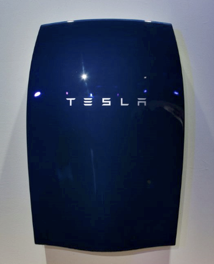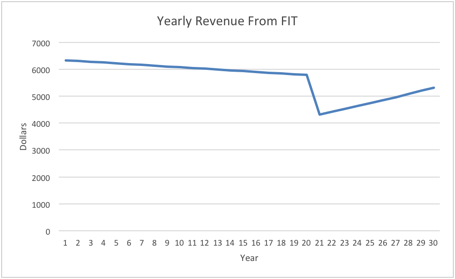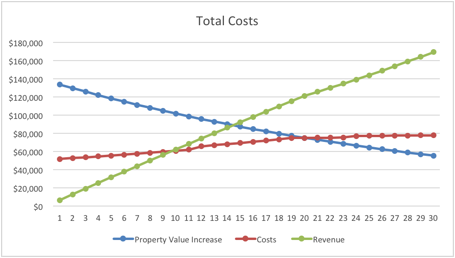Advertising
Living Disconnected – Myth or Reality? - Further Investigations - Part 3
Posted on Apr 19, 2016

by Andrei Adam & Aidan Lehal
9. Further Investigation
Even though we believe that we conducted our study in a comprehensive manner within the time we had available, there are things we now know we can improve on if we were to broaden our study.
One of such things would be to have a larger data set of electricity consumption than the one we had, specifically more than one year. The year of 2015 had a milder than usual summer and colder than usual winter which might have affected the results.
Another way we could develop our study further would be to optimize the amount of PV panels to be installed so that we are not paying extra for solar panels that produce electricity that but cannot be used or stored. In our project we installed the maximum amount of PV panels that the roof allowed us even though we might have been able to supply our electricity needs with less. This would help us save costs and make going off-grid even more financially feasible.
Alternatively, we could calculate the benefits of supply the excess energy back into the grid under different available plans (Feed in Tariff or net metering). This would allow us optimize the financial reward of installing the PV system and make sure that no electricity goes to waste. We further explored this option below, as an extension to our project – see next section.
Another component that would be interesting to be taken into account is the evolution of the PV panels and the costs of the entire system. The U.S. NRL is forecasting a drop of more than 16% in price for every doubling of the amount of the installed PV panels around the world. With the current exponential increase of PV installations around the world the cost of PV panels is set to continue to decrease dramatically in the future. It would be interesting to conduct our study in 5 or 10 years to see how the technology and the results would have evolved.
Lastly, with all the acquired information and knowledge, a computer application could be created to help the homeowner in any part of the world to calculate the costs and benefits of installing a complete PV system. Specific information such as local sun conditions and electricity cost, along the current price of components and installation of the system could be built and available through a user-friendly app. This would make our study easy to access and used for everyone, helping reach more people.
If the further investigations above are conducted, we hope that our project will have greater effects on everyone and will convince even more people to leap onto the renewable revolution and live disconnected.
9.1 Exploring the Possibility of Supplying Excess Electricity to the Grid
From the PV system we created above, we are producing more electricity than we consume or can store. For example, in summer we produce an average of 72.3 kWh a day, while only consuming 6 ½ kWh of that. Even with the 40 kWh battery, once it is full, we are wasting all the electricity we produce and do not consume. To prevent wasting this electricity we generate and to help power other homes in Ontario cleanly and renewably while earning money to offset the costs of the system, we could sell electricity back to the grid.
There are two modalities to sell the electricity to the grid. One is through net metering, which means that only the electricity that we do not consume is sold back at the regular electricity prices. The second option is to sell all the green electricity we produce through the Feed in Tariff (FiT) program at the FiT prices, which are significantly higher than the regular electricity prices.
The FiT program provides the opportunity to anybody with a 10 to 500 kW renewable electricity system to sell all their electricity produced back to the grid at a guaranteed price over a 20-year term.
Because we are selling all our electricity to the grid, we also have to buy what we consume. However, because the FiT program pays a much better price than we pay for the electricity we consume from the grid, the difference in price is an additional financial benefit to the homeowner.
The Economic Case
Due to the fact that we have a rooftop PV system with a production capacity between 10 and 100 kW, we would receive 34.3 cents for every kWh we supply to the grid. For this reason, in the following calculations we will assume that we are going to be locked-in a 20-year contract at 34.3 cents under the FiT program. After 20 years, we assume that the FiT program is no longer in effect, and only the net, surplus, electricity will be sold back to the grid at the price of electricity at that time.
Using the production and consumption values determined previously in our analysis, the annual energy amount we can sell to the grid is presented in the graph below.

The graph above shows how many kWh we can sell to the grid annually throughout the lifespan of the PV system. The reason why the amount decreases as we progress further from the first year is because the solar panels slowly deteriorate and lose some of their production capacity each year (around 0.6% annually). It can be observed that the energy to be sold after the first 20 years drops as only the net energy will be sold.
Assuming that the FiT program will pay 0.343 cents (today’s prices) per hWh for the first 20 years and, after that, the net electricity will be sold at a price of 31.6 cents and increases 3% annually, in line with the expected on-peak electricity average price between the 21st and 30th year, the graph below presents the annual revenue we will receive over the lifespan of the system.

It could be observed that we would receive between $6350 and $5000 annually. The amount we receive decreases gradually because the solar panels produce less electricity over time, and the drop in the 21st year is when we exit the FiT contract. The increase in price following the 21st year is because the predicted price of electricity will increase 3% annually.

The graph above shows the total revenue we would receive over time through the FIT program. Through 30 years, we would receive a total revenue of just under $180 000.
Total Costs
The graph below shows the total costs, revenue and property value increase under this scenario.

The property value increase is the same as an off-grid system. The “costs” now includes the cost of the PV system without the battery and backup generator; we can always draw power from the grid when we need it, as well as the projected electrical bill costs, as we would have to buy our electricity from the grid for the first 20 years. The revenue is that of which we would get from selling electricity to the grid.
It can be observed that it takes 10 years to break even on our investment without selling our home. In total, we would make a profit of over $80 000 throughout the lifespan of the PV system.
Final Thoughts and Conclusion
How do these results impact the research we did into the off-grid system? For people living in more rural areas, in places that the electrical grid fails to cover or charges you lots to be connected, an off-grid system is still the way to go. That said, we do not expect many other people to go off the grid, as they likely will not easily recover money on their investment. Instead, we hope that the off-grid portion of our project showed homeowners the potential of solar panels - who knew you could power your home only using the sun? - but now we justified the financial aspect of installing them, through joining the FIT program or selling the excess power to the grid.
For now, more people may want to take this smaller step, installing solar panels while remaining grid-tied, rather than going completely off the grid. This extension of our project was meant to tie in with what we attempted to do throughout our whole research, and show what solar panels can do for you: not only can they power your home singlehandedly without sacrificing your current lifestyle, they can also earn you constant revenue in the long run.
10. Acknowledgements
We would like to acknowledge a few people who helped make our project a reality.
First and foremost we would both like to thank Gabriel Adam for his knowledge and guidance throughout the project. You really helped open our eyes to new possibilities and ways to make our project even better with your 20 year knowledge of being an electrical engineer.
We would also like to thank Mrs. Longden for being able to help create and adjust our deadlines and to make sure we reached them. The way you sacrificed your breaks to let us work in your classroom was an essential piece to finishing our project on time.
In addition, we would like to thank John Wilson for his knowledge and expertise in the workings of the off-grid system and for allowing us into his home to view his PV system.
Lastly, we would like to thank the people who told us that to install solar panels on a home in the GTA would be unwise and not useful, mindless to completely disconnect from the electrical grid. Without you, we would have never gotten the motivation to start this project in the first place. We hope we changed your mind and showed you that solar panels have limitless potential, and it is all up to you whether or not to capitalize on it.
11. Bibliography
http://cleantechnica.com/2012/03/21/history-of-solar/
http://hespv.ca/residential-solar-energy-systems/solar-off-grid-canada/off-grid-solar-panels
http://www.homepower.com/articles/solar-electricity/design-installation/or-grid
http://www.motherearthnews.com/renewable-energy/pros-and-cons-of-going-off-the-grid-z10b0blon.aspx
http://www.forbes.com/sites/morganbrennan/2012/11/15/off-the-grid-mansions/#2715e4857a0b24fe6e131f30
http://inhabitat.com/tiny-off-grid-cabin-in-maine-is-completely-self-sustaining/
http://www.countrysidemag.com/91-6-rex-a-ewing/
http://cleantechnica.com/2015/01/29/solar-costs-will-fall-40-next-2-years-heres/
http://cleantechnica.com/2011/06/10/solar-power-graphs-to-make-you-smile/
Sunlight
http://aa.usno.navy.mil/data/docs/Dur_OneYear.php
http://www.livingin-canada.com/sunshine-hours-canada.html
Solar Panels
http://www.livescience.com/41747-best-solar-panels.html
http://solar-panels-review.toptenreviews.com/
http://www.rapidtables.com/calc/electric/watt-to-kwh-calculator.htm
http://www.sharpusa.com/SolarElectricity/SolarProducts/ResidentialSolarProducts.aspx
http://www.gogreensolar.com/products/sharp-nd-250qcs-250-watt-solar-panel
http://www.canadiansolar.com/solar-panels/cs6x-p-fg.html
Battery
http://batteryuniversity.com/learn/article/can_the_lead_acid_battery_compete_in_modern_times
http://www.wholesalesolar.com/1898730/crown/battery-banks/crown-860ah-24vdc-20-640-watt-hrs-8
http://www.wholesalesolar.com/1898575/upg/battery-banks/upg-deep-cycle-400-ah-48-vdc-19-200-wh-16
http://www.greentechmedia.com/articles/read/Reporting-Live-From-the-Tesla-Mystery-Product-Unveiling
https://www.teslamotors.com/en_CA/POWERWALL
http://www.offthegridnews.com/grid-threats/the-absolute-best-batteries-for-off-grid-energy-systems/
Inverter
http://www.wholesalesolar.com/2931714/sma/inverters/sma-sunny-boy-5000tl-us-22-inverter
http://www.mastervolt.com/news/lifespan-of-solar-inverters/
Backup generator
https://www.homedepot.ca/en/home/p.3000-watt-generator.1000730038.html
Costs and Return on Investment
http://energyinformative.org/solar-panels-cost/
http://www.yourturn.ca/solar/our-system/how-much-did-it-cost/
http://ottawacitizen.com/news/local-news/electricity-prices-to-increase-just-in-time-for-winter
Exploring the Possibility of Supplying Excess Electricity to the Grid
http://fit.powerauthority.on.ca/fit-program/fit-program-pricing/fit-price-schedule
https://www.horizonutilities.com/ConnectingGeneration/Pages/SellingElectricityGrid.aspx
http://fit.powerauthority.on.ca/fit-program